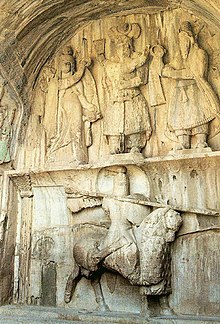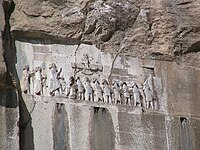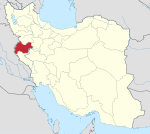
Tehran province is one of the 31 provinces of Iran. It covers an area of 18,814 square kilometres (7,264 sq mi) and is located to the north of the central plateau of Iran.
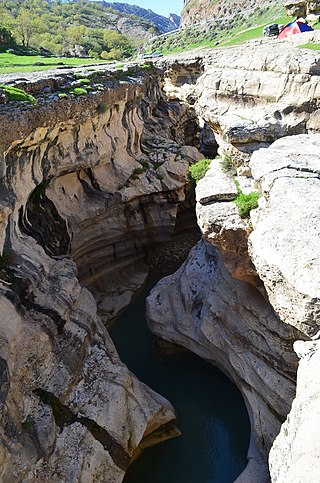
Ilam Province is one of the 31 provinces of Iran. It is located in the western part of the country in Region 4 and covers 20,164.11 km2 (7,785.41 sq mi). It shares 425 km (264 mi) of the border with Iraq, and also bordering on the provinces of Kermanshah, Lorestan, and Khuzestan. The largest city and also the provincial capital is Ilam.

Khuzestan province is one of the 31 provinces of Iran. Located in the southwest of the country, the province borders Iraq and the Persian Gulf. Its capital is Ahvaz and it covers an area of 63,238 square kilometres (24,416 sq mi). Since 2014, it has been part of Iran's Region 4.
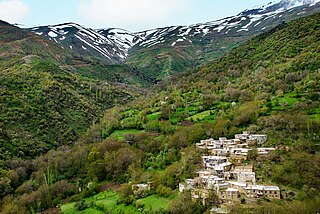
Kurdistan or Kordestan province is one of the 31 provinces of Iran. The province is 28,817 km2 in area and its capital is the city of Sanandaj. Other counties with their major cities are Saqqez, Baneh, Marivan, Qorveh, Bijar, Kamyaran, Dehgolan, Diwandarreh and Sarvabad.
Laki is a vernacular that consists of two dialects; Pish-e Kuh Laki and Posht-e Kuh Laki. Laki is considered a Kurdish dialect, by most linguists and is spoken chiefly in the area between Khorramabad and Kermanshah in Iran by about 680,000 native speakers.

Kermanshah, is the capital of Kermanshah Province, located 525 kilometres from Tehran in the western part of Iran. According to the 2016 census, its population is 946,651.

Taq-e Bostan is a site with a series of large rock reliefs from the era of the Sassanid Empire of Persia (Iran), carved around the 4th century CE.

The Anahita Temple is the name of one of two archaeological sites in Iran popularly thought to have been attributed to the ancient Iranian deity Anahita. The larger and more widely known of the two is located at Kangāvar in Kermanshah Province. The other is located at Bishapur.
Kurds in Iran constitute a large minority in the country with a population of around 9 and 10 million people.
Kangavar, also Romanized as Kangāvar, is a city in the Central District of Kangavar County, Kermanshah province, Iran, serving as capital of both the county and the district.
Qasr-e Shirin also Romanized as Qasr-e Širin and Qasr-e-Shīrīn; also known as Ghasr-ī-Shīrīn and Ghasr-Shīrīn; Kurdish: قەسری شیرین, romanized: Qesrî Şîrîn, is a city in the Central District of Qasr-e Shirin County, Kermanshah province, Iran, serving as capital of both the county and the district. Its population in 2016 was 18,473. It is a Free-trade zone (FTZ) and is populated by Kurds.
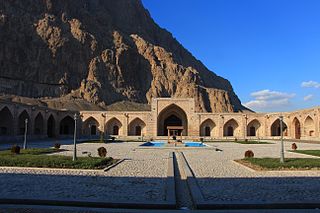
Bisotun, also Romanized as Bīsotūn; also known as Bīsītan and Bīsītūn, is a city in, and the capital of, Bisotun District of Harsin County, Kermanshah province, Iran. It also serves as the administrative center for Chamchamal Rural District.

Behistun palace is a ruined Sassanid palace located in Bisotun, 20 kilometres (12 mi) from Kermanshah, Iran. It faces the cliff with the much older Behistun inscription and rock relief, across the ancient road running between Behistun mountain and Behistun lake. The palace has long been regarded in Persian tradition as a residence of Shirin, queen of Khosrau II, the Sassanid Shah of Persia who reigned from 590 to 628, shortly before the Muslim conquest of Persia. This connection is first documented, in surviving records, by early Islamic geographers, and is elaborated in various later stories and myths, as a fictionalized Shirin became an important heroine of later Persian literature, such as the Shahnameh. It is included in the UNESCO World Heritage Site of Bisotun.
Khosravi, also Romanized as Khosravī and Khosrovī; also known as Khosrowvī, Khūsrawī, and Khūsrovī, is a village in, and the capital of, Alvand Rural District of the Central District of Qasr-e Shirin County, Kermanshah province, Iran. The village is populated by Kurds.

The Anubanini petroglyph, also called Sar-e Pol-e Zohab II or Sarpol-i Zohab relief, is a rock relief from the Akkadian Empire period or the Isin-Larsa period and is located in Kermanshah Province, Iran. The rock relief is believed to belong to the Lullubi culture and is located 120 kilometers away from the north of Kermanshah, close to Sarpol-e Zahab. Lullubi reliefs are the earliest rock reliefs of Iran, later ones being the Elamite reliefs of Eshkaft-e Salman and Kul-e Farah.
Zangana is a Kurdish tribe in Kermanshah province and some parts of Iraqi Kurdistan. They speak a distinct dialect. However, in recent years they have linguistically assimilated into the language practice of Sorani speakers in the area in which they live.

On 12 November 2017 at 18:18 UTC, an earthquake with a moment magnitude of 7.3 occurred on the Iran–Iraq border, with the Iraqi Kurdish city of Halabja, and the Kurdish dominated places of Ezgeleh, Salas-e Babajani County, Kermanshah Province in Iran, closest to the epicentre, 30 kilometres (19 mi) south of the city of Halabja, Iraqi Kurdistan.

Kameel Ahmady is a British-Iranian scholar working in the field of social anthropology, with a particular focus on gender, children, ethnic minorities, and child labour. Kameel Ahmady, born in 1972 in Naghadeh, West Azerbaijan Province, is an Iranian-British researcher and social anthropologist known for his research and activities in the fields of social anthropology and harmful traditional practices. He is the coordinator and developer of more than 11 research study books and 20 scientific articles in Persian, English, Turkish, and Kurdish on subjects such as child marriage, temporary marriage, White marriage, female genital mutilation/cutting (FGM/C), Male circumcision, child labour and children's scavenging, LGBTQ+ issues and identity and ethnicity.
Rahahane Gharb or Iran's west railway is a partially finished railway corridor in western Iran.

Kermanshah Nabi Akram Corps is a military unit under IRGC and Basij. Their headquarters are located in Kermanshah, and they are the main unit in Kermanshah and are responsible for commanding all Corps and Basij units located in Kermanshah province.

